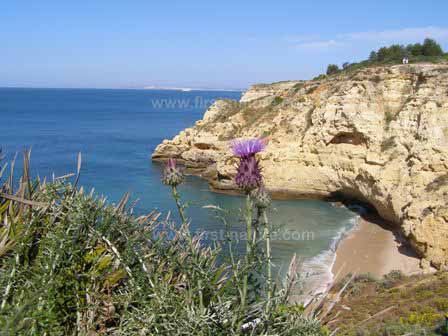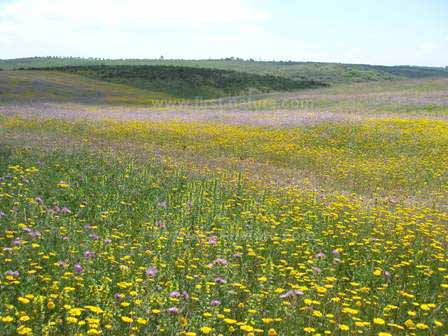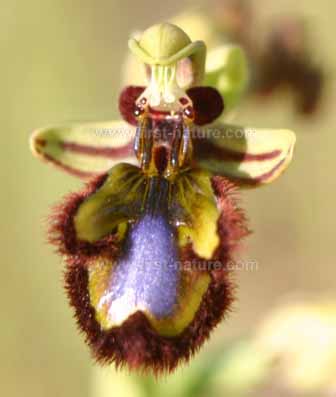The Algarve, Portugal - guide to the wildflowers, wildlife and nature reserves
Some of the Wildflowers in the Algarve...

Typical Algarve coast scene with Onopordum illyricum in the foreground
Although the Algarve faces the Atlantic Ocean, its climate owes much more to the Mediterranean region and shares the mild, wet winters and hot, dry summers associated with its neighbour, Spain, and the other countries that surround the Mediterranean basin. Despite the ongoing development of holiday villas and golf courses in the Algarve, much of the coast has been set aside as nature reserves and so it remains a paradise for wildflowers, birds and many other species of wildlife.
To get the most out of a trip to see the wildflowers, and wild orchids in particular, that flourish in the Algarve it is best to visit during the spring - March and April are ideal months. The weather is generally warm and sunny and you will be greeted by a bewildering profusion of flowers wherever you turn.
Excursions along the coastal strip, sometimes referred to as the littoral zone, are a great way to start. This part of the Algarve contains a habitat known as garrigue - an area close to the sea with dense cushions of plants, pruned by the winds and with well defined bare, stony areas in between making the going quite comfortable. In other parts of the coast there are woodlands consisting mainly of the Umbrella (or Stone) Pine (Pinus pinea) which is one of the few trees that can withstand the harsh, salt-laden and windy conditions found there. Further inland is another distinctive habitat referred to as maquis and this supports taller and more dense shrubs which can be almost impenetrable. Few of these areas are without some clearings allowing access, and it is there that you can discover many botanical wonders. Higher up and further from the coast is the mountainous region, sometimes called the serra, which is forested with native cork oaks (Quercus suber), pines and imported Eucalyptus trees. This part of the Algarve also has open, rocky areas which support numerous plants and which frequently resemble rock gardens, although these are populated with wildflowers and not cultivars.
In between the coast and the mountains there are extensive areas of farmland and, unlike the farmland we are used to in Britain, which is virtually devoid of wildflowers due to the excessive use of herbicides and pesticides, these fields in the Algarve are home to an astonishing variety of wildflowers. In cultivated field margins you will find many flowers. Similarly, farmland that is either abandoned or being allowed to lie fallow is immediately taken over by vast numbers of wildflowers, as the picture below illustrates.

An Algarve field that is lying fallow has become home to thousands of wildflowers
The Algarve is home to a fascinating range of rare and beautiful wild orchids including the Bee Orchid (Ophrys apifera), Broad-leaved Helleborine (Epipactis helleborine), Sawfly Orchid (Ophrys tenthredinifera), Man Orchid (Orchis anthropophora) and numerous others many of which are easy to find. You can find pictures and descriptions of many of the orchids on this website in the Southern European section of the wildflower garden.

The Mirror Orchid (Ophrys speculum) is a real speciality of the Algarve
Many of the lovely wildflowers of the area are easily accessible and seem to grow almost anywhere during the spring and early summer, but if you want to see some of the rarer ones, and to enjoy some of the other wonderful wildlife of the region, the national parks and reserves are good places to start. Below are links to detailed information about the most important wildlife areas and natural parks of the Algarve:
Parque Natural da Ria Formosa
Reserva Natural do Sapal de Castro Marim e Vila Real do San Antonio
Parque Natural do Vale do Guadiana
Parque Natural da Sudoeste Alentejano e Costa Vincentina - Cape St. Vincent
Fonte de Benemola
More about the Algarve and its wildlife...
Top of page...